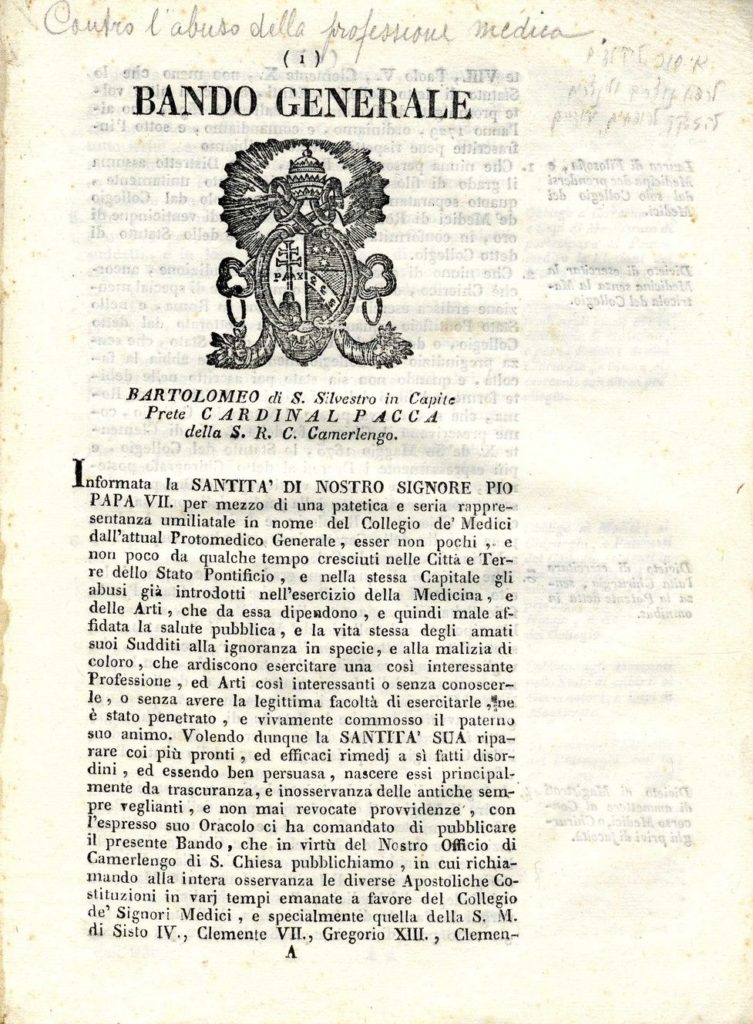
[12] pages. Bando Generale [general notice]. Anti-Semitic publication from the Roman church, forbidding Christians from selling medicine or healing Jews, and forbidding Jews from employing a Christian doctor. Rome, 1812. The bylaws, published by the church, include a sharp ban on Christian merchants from selling any type of medicine to the Jews. A merchant who does sell to Jews will be fined 25 gold coins, and a Jew who purchased medicine or was healed by a Christian would be banished from the country. The document includes “economic” excuses regarding the “sins” of the Jews that justify these new bylaws. Very fine condition.
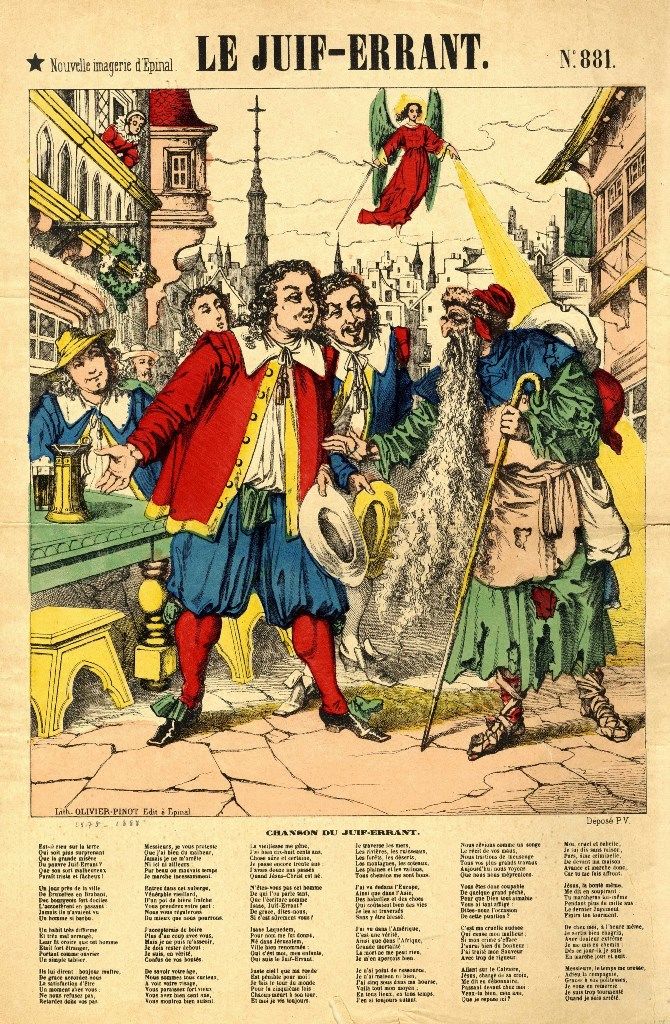
Dimensions: 40×27 cm. An antisemitic plate in lithographic printing painted by hand from the time of printing published by Epinal. The lithograph was done by Oliver O. Pinot. The lithograph is accompanied by verses of an antisemitic poem in rhyme, in French, about the legend of the wandering Jew. In the illustration is a Jew with a long curled beard, and a long nose, holding a walking stick in his hand. The people around him who depict the natives of the place seem much cleaner and tidier than him, and they are all looking at him suspiciously. Similar lithographs were published in 19th century France bearing the title La Juif Errant in which the poem before us appears with the illustrations of the artist Francois Georgin. Pasted onto a cardboard back for protection, a restored tear at the bottom of the paper. Fine condition.
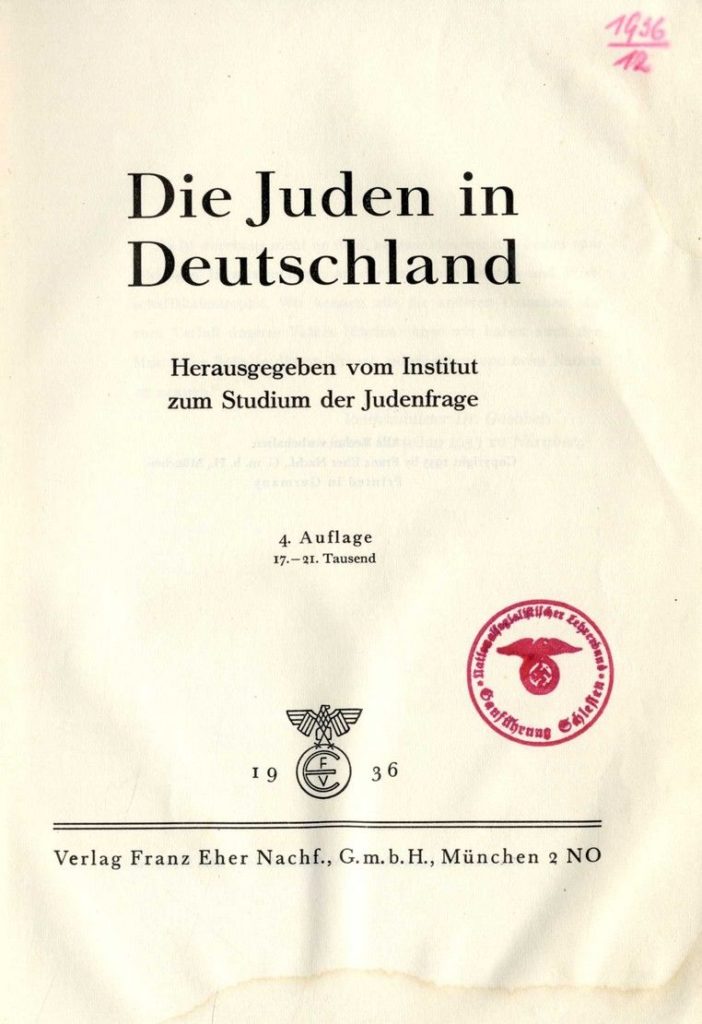
* L’Esprit Juif by Gore O’ Thouma, Tulle [France], 1888. An antisemitic work in French, which argues that the Jews are racially weak according to their own view of themselves. * Zur rassen und ostjudenfrag by Dr. e.zivier. Poznan [Germany] 1916, German. An antisemitic work which discusses “The racial problem of the Eastern Jews”, with many claims of racially inferiority of Eastern European Jews. * La conscienee chretienne et l’ affaire dreyfos [The Christian Conscience and the Dreyfus Affair], by Labbe Pichot, Paris 1899, published by societe d’editions litteraires. * Die Juden in Deutschland, published by Franz Eher Nachf. Munich, 1936, German. A book published through the initiative of “The Institute for Research of the Jewish Question in Germany”, and which had a great influence on increasing antisemitism within the highly educated sector of the German population in the 1930’s. The book is full of antisemitic claims about the Jews who are presented as the main cause for all of Germany’s troubles. At the beginning of the book is a quote from the Minister of Propaganda Jospeh Goebbels from a speech which he delivered in 1933 in Nuremberg – where he expresses the famous claim that “The Jews are to be blamed for everything” saying: “It is under no circumstances an injustice, that we have found the Jews to be the ones mainly guilty for the general tragedy around us. We are aware of all of the other causes, the aspects which led to the dimming of our nation. But we also have to be brave and call the child by its name…” [the source is in German]. On the book’s title page is the official stamp of the German Reich. OCLC lists only five copies of this book throughout the world. * Blutbeschuldigung der Juden [The Blood Guilt of the Jews], published by Walther & Apolant, Berlin, 1882. In the book the author reveals various official documents [most of them from the same year – 1882] which were published in various legal opportunities in Germany, in which the blood libel of Christian blood from the Middle Ages, regarding use of Christian blood to bake matzot on Pesach still appears, and not, as there were those who thought, that this was a libel which disappeared from the world. Varying sizes and conditions. Overall fine condition.
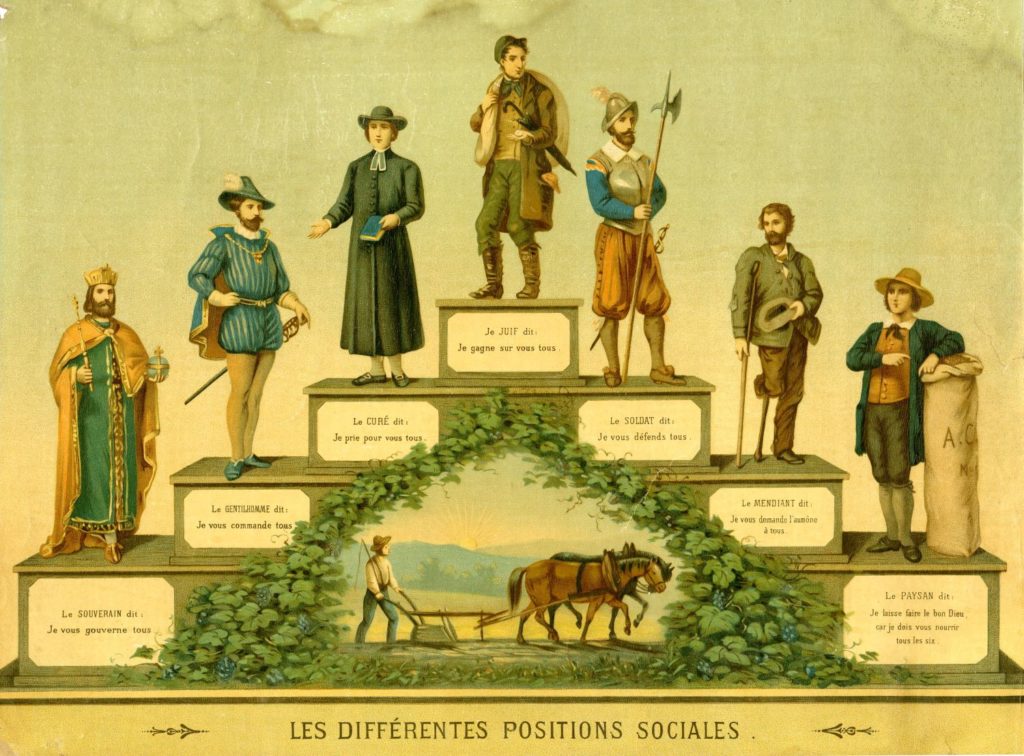
Les Différentes Positions Sociales [The Different Social Positions]. Color lithograph print. Without neither publisher’s nor printer’s names. [France? Late 19th Century]. French.
Antisemitic print showing stairs with seven figures on them – a governor, a nobleman, a priest, a Jew, a soldier, a beggar and a farmer. Under each figure, there is a naive saying attributed to it. The Jew, dressed in the outfit of “The Wandering Jew” [the stereotypical character of a Jewish figure in France of the 19th century] with a wanderer’s satchel on his shoulder, standing in the middle on the uppermost stair with the saying, “I beat all of you.” There was a similar print appearing in Frankfurt at the same time in which the saying attributed to the Jew was, “I must live from the profits.”
Size: 41×32 cm. Stains, fine condition.
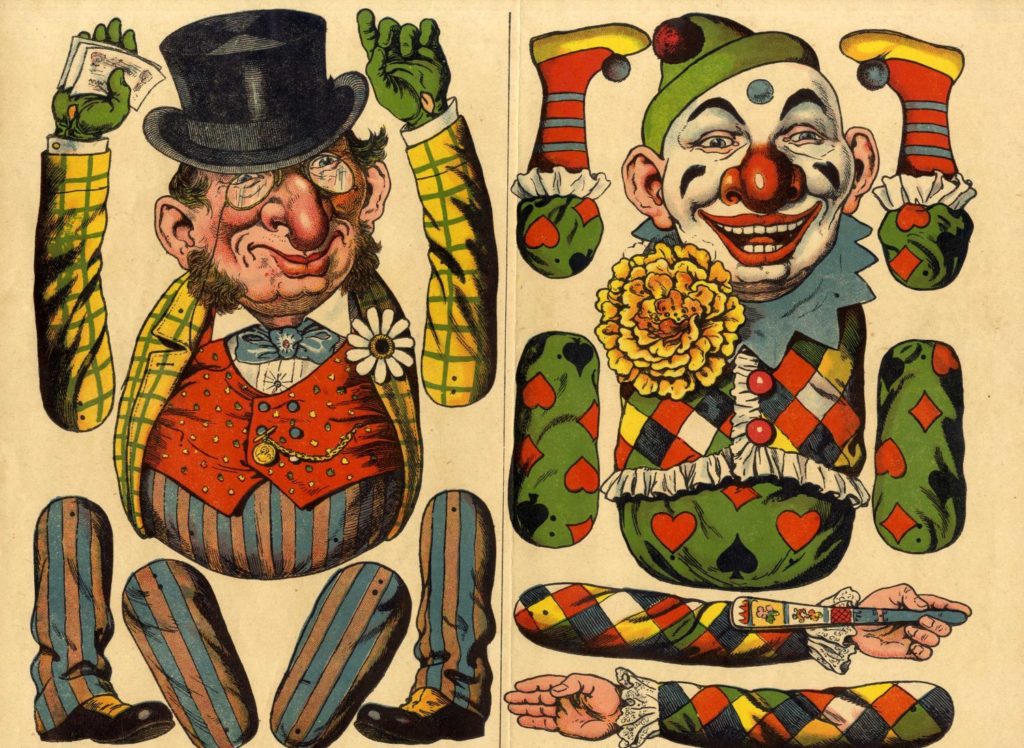
Antisemitic poster [cutout?] depicting gentile and Jewish clowns facing each other. Germany, c. 1930s. Unknown.
Leaf apparently meant for cutting and assembling the figure of a clown. There is a gentile clown on the right with a smiling face and colorful lively clown costume in contrast to the Jewish clown on the left: the image of a banker waving money in one hand and shaking the other in a threatening manner. He has a long nose, a serious face and a fake closed-mouth smile. Where there is a large, impressive flower on the gentile’s outfit, there is a small, simple flower on the Jew’s. “Ziehfigur” appears on the lower left.
Size: 34×41 cm.
Very fine condition.
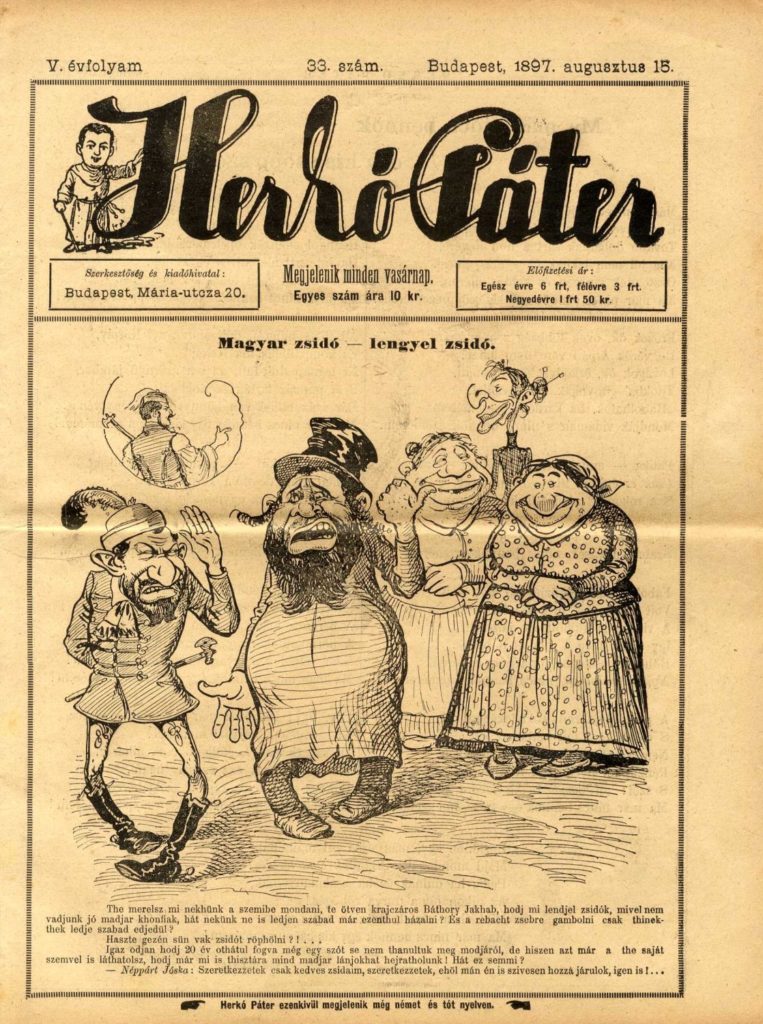
* Issue no. 33 from August 15, 1897. The front page of the newspaper features an antisemitic caricature depicting two ridiculous Jewish stereotypes, one called Magyar Zsido [“Hungarian Jew”], and the second, Lengyel Zsido [‘Polish Jew’]. The inner pages feature antisemitic caricatures.
* Issue no. 48 from November 29 1896. The front page of the newspaper features an antisemitic caricature. Bound with:
* Issue no. 49 from December 6, 1896. The front page of the newspaper features an antisemitic caricature, as well as various antisemitic caricatures with antisemitic captions on the inner pages.
Overall very fine condition.
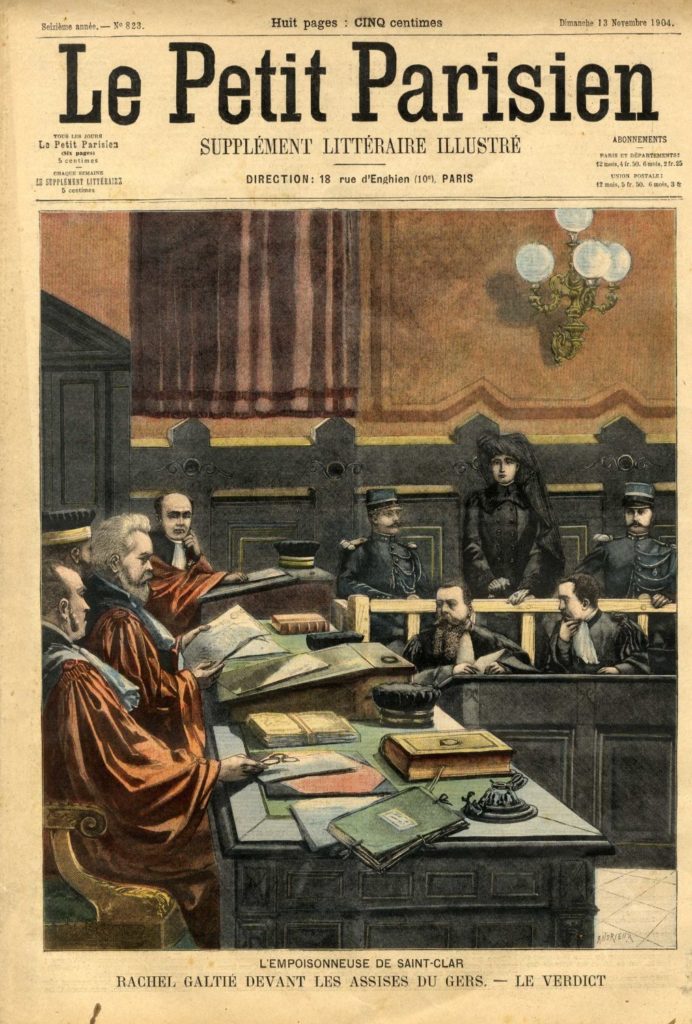
Four newspaper issues from important dates in the Dreyfus Affair.
* L’Illustration Journal Universal from February 12 1898 – Émile Zola in the courtroom.
* L’Illustration Journal Universal from August 19 1899 – after Dreyfus was found guilty under extenuating circumstances and sentenced to ten years imprisonment – Lavoro’s breakdown (he was a controversial figure in relation to Dreyfus).
* L’Illustration Journal Universal from July 8 1899 – Dreyfus on the boat on his way to imprisonment on Devil’s Island.
* Le Petit Parisien – from November 13 1904 – from within the courtroom. The photographers were not allowed to photograph inside the courtroom; the public received pictures of what was happening inside the courtroom by work of the best illustrators of the time, which were published by the press.
Overall very fine condition.
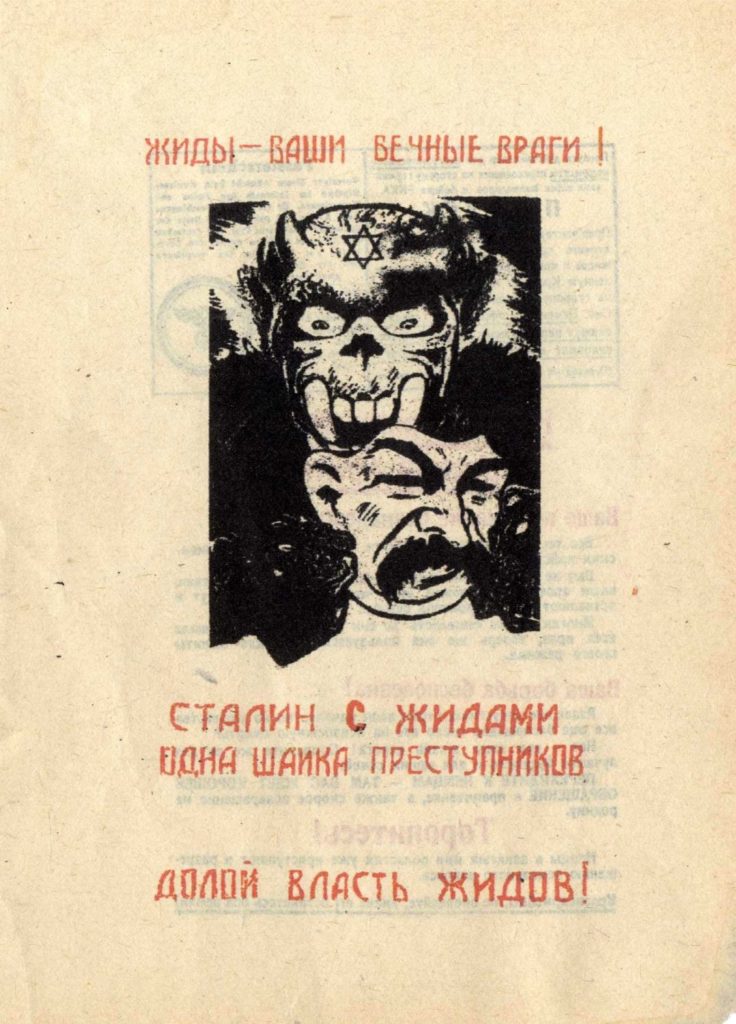
Four illustrated antisemitic posters with Russian texts. Russia, c. 1930s.
Includes: Poster with a Jew depicted as a monster with a star of David on his head, holding a Stalin look-alike mask. Poster of a Jewish character with a long nose, winking, within a star of David. A Jew plowing and a grotesque figure wailing underneath it. The back of the posters feature the emblem of the Nazi party. All the posters have antisemitic Russian texts.
Identical size: 21×15 cm. Fine condition.
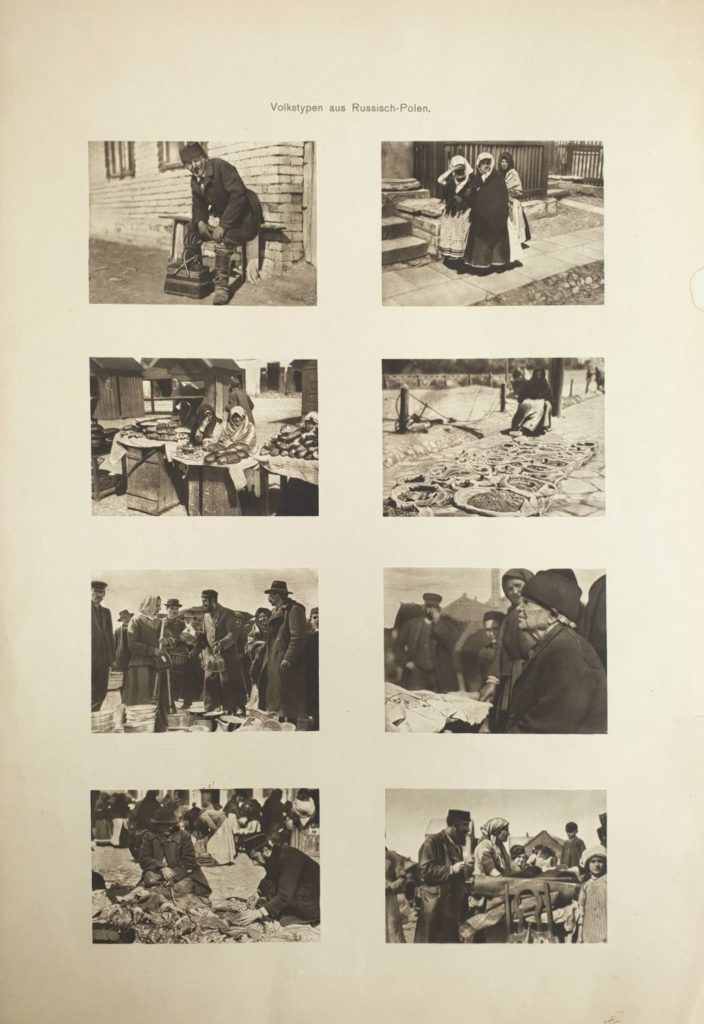
Poster titled ‘volkstypen aus russisch-polen’ – types of peoples in Russia and Poland. Graphic antisemitic poster with eight photographed pictures of views of Jews in a market, [female] Jewish merchants, an elderly Jewish beggar.
Posters of this type were distributed in Germany and meant for the “enlightened” German people to show Jews ‘as they are’ where they live among themselves [‘Juden under sich’], images such as these always filled the antisemitic Der Stürmer as well as Berliner illustriete Zeeitung , accompanied by virulently inciteful antisemitic articles entitled “Jews Among Themselves.” The photographic style of Nazi propaganda focused on the faces of the subjects of the photographs to demonstrate the physical characteristics of races which were considered inferior.
34×54 cm. Thick paper. Very fine condition.
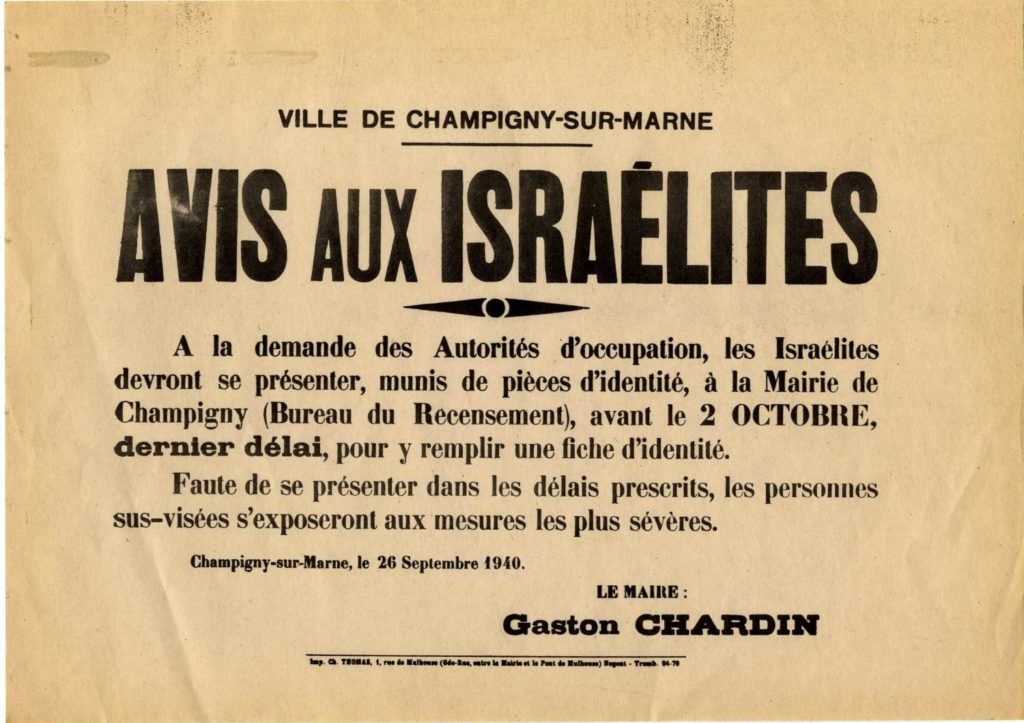
Avis aux Israelites – Notification for Jews. Leaflet on behalf of the authorities in France turning to the Jews with the demand they report to the building of the municipality soon, before the October 2nd deadline, for the purpose of completing the registration of their personal details, in a l eaflet threatening that if they don’t come on time, the Jews will be punished with “the most severe punishment.” France 1940.
France was conquered by Nazi forces in June, 1940. It was divided into the German occupied territory in the north and the west; and an ostensibly independent state in the south, called Vichy France, due to the fact that its government sat in the free city of Vichy. The new French state, headed by Henri Philippe Pétain, established a regime of cooperation with the Nazis, and maintained a passive and submissive policy, including cooperation with the extermination of its Jews.
Size: 22×30 cm. Very fine condition.
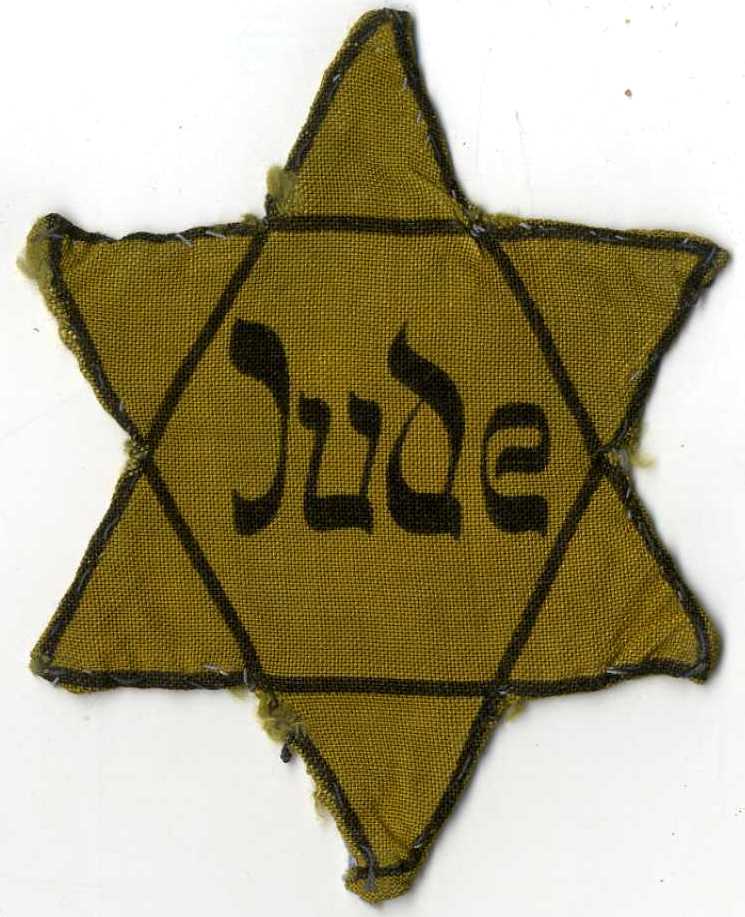
Yellow fabric patch in the shape of a star of David with “Jude” written in the center, late 1930s or early 1940s.
According the German Reich regulations, beginning in 1938, every Jew in occupied German territory was required to wear a yellow patch. The patch had to be at least 10 cm, shaped in the form of a star of David, and have “Jude” written in the center. According to the instructions, the patch had to be worn over the garment on the left side of the chest, or on the upper right arm. Jews who forgot the patch when they went out into the street, or wore a patch which did not meet the instructions, were officially expected to receive fines or imprisonment. At the entrances to the homes in Warsaw, warnings were posted against forgetting the armband. In an announcement by the Judenrat on July 26, 1941, it was reported that “according to the authorities’ warning, Jews who do not wear the yellow patch on their chests and on their backs will be harshly punished – including death by gunfire.” The countries where the yellow stars were most commonly used were Germany, France and the Netherlands.
8×10 cm. Fine condition.
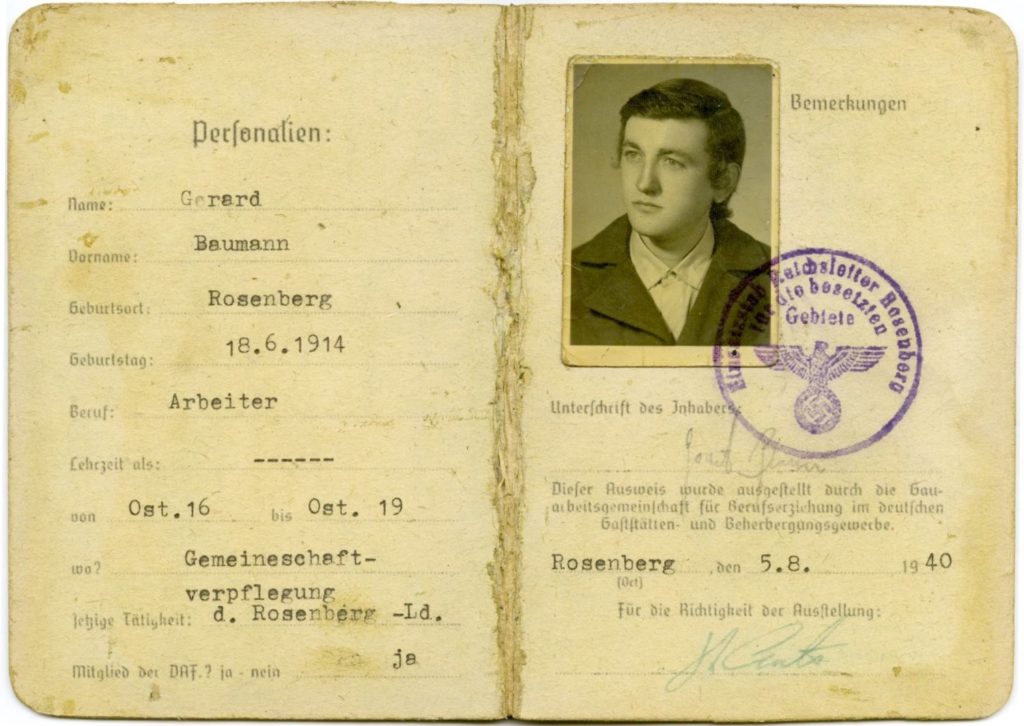
Arbeiter – worker’s card for a Jew named Gerard Rosenberg, b. 1914 [Rosenberg apparently worked in a German refinery]. Details were filled in on 5/8/1940.
Rosenberg’s passport photograph appears on the card, as well as his signature and two ink stamps with the German Reich emblem, and a printed swastika.
10×14 cm. Fine condition.
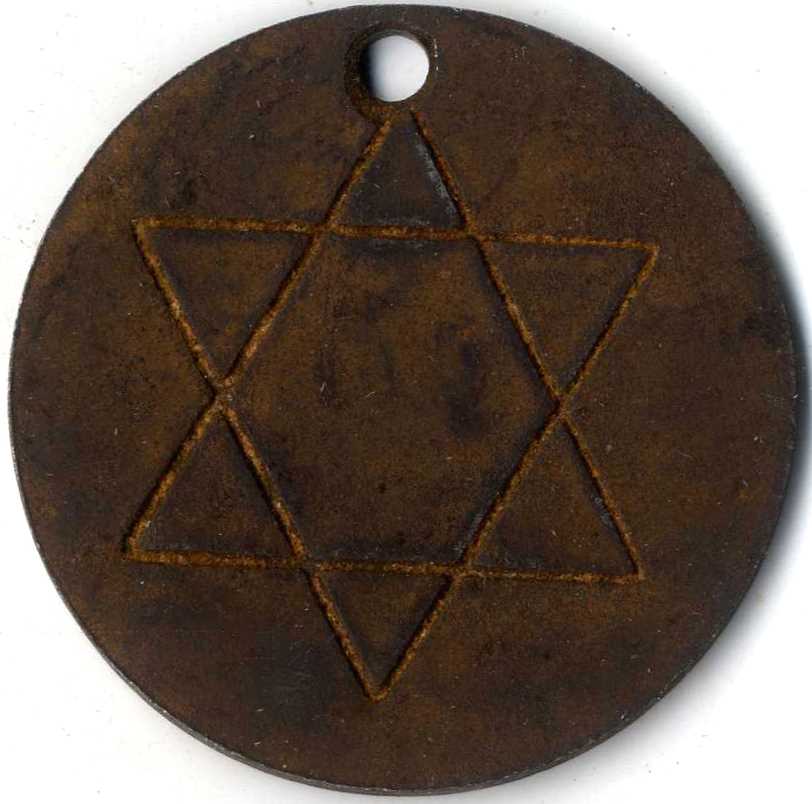
ID pendant for a Jew in the Sonderkommando unit of the Stutthof death camp. The front bears his personal number: 396 and the inscription “Stutthof Block A” with a swastika on top. Star of David on the reverse. Rare.
The Sonderkommando special unit was the unit which dealt with the casualties of the destruction in the gas chambers. The Jews worked in this unit by forced labor, and their job was to remove the corpses from the gas chambers and to burn them in the crematoria. After functioning a number of months, the members of the Sonderkommando itself were executed and their corpses were removed by the next unit in turn. The swastika symbol on the pendant marked them as “workers” in the service of the Nazis. The star of David on the reverse identified the worker as Jewish. Historian Hermann Langbein wrote “By order of Adolf Eichmann, most of the Sonderkommando personnel were executed after each perpetration of execution, because they were aware of Nazi secrets.” The situation of the Sonderkommando personnel was incomparably better than the rest of the inmates, as testified to by a survivor of Auschwitz and member of the Sonderkommando, Josef Zacker: “We knew no lack – whether in clothing, food nor sleep. We did not suffer from starvation or lack of sleep, we had clothing and shoes for the duration. Clearly, only we, the Sonderkommando, received these benefits, the rest of the prisoners could only dream of them. The conditions in our block were exceptional. We had bathtubs in the crematoria and in our camp blocks. In the crematorium, there was a bathtub in the residential floor. We also had bathrooms in the block.”
For the six years of the existence of the Stutthof concentration camp, which was located east of Danzig, near the city of Stutthof, approximately 110,000 people were imprisoned, of which 85,000 were killed. Gas chambers and crematoria were built in the camp in 1943 in order to begin mass executions, as Stutthof was included in the “final solution” of June 1944.
Diameter: 3.2 cm. Rust stains. Fine condition.
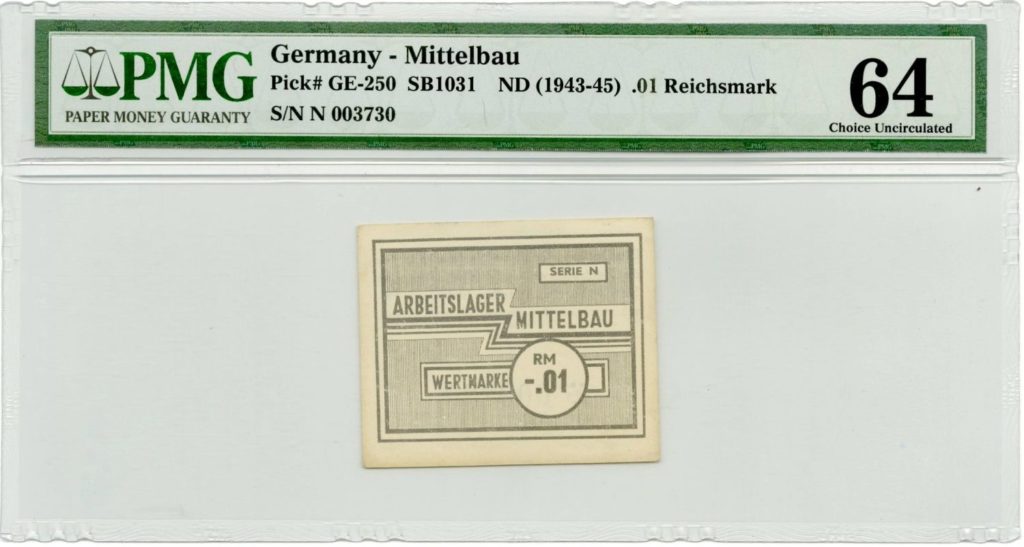
ARBEITSLAGER MITTELBAU means of payment in the Mittelbau Labor Camp rated 64 Choice Uncirculated by the PMG.
KZ-Dora-Mittelbau; [also called Mittlebau-Dora, or Nordhausen] served as a Nazi labor camp during the period of the Holocaust. The camp was located in central Germany near Nordhausen. The laborers were forced to produce V-2 missiles in underground factories. Of about 60,000 prisoners “employed” at the labor camp by forced labor, it is estimated that 20,000 were killed. Exhaustion from the hard labor, terrible sanitation conditions, executions and hunger were the principle causes of death. It was the central labor camp; it had approximately forty sub-camps. The prisoners were left in tunnels 24 hours a day, without seeing any daylight, in very harsh working conditions, with even minimal security or welfare: work for six days in 12-hour shifts. The prisoners suffered from cold and hunger and from the brutality of the German workers.
Although the SS actually ran the camp, the Metalwork company which manufactured the missiles supplied the prisoners with shoes and other items, and the prisoners had the right to buy in a “canteen.” It is rare to fine payment means from this camp in this condition.
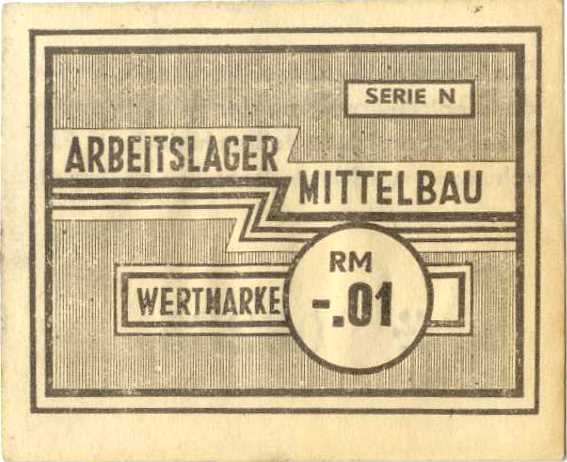
Payment means for the Mittelblau labor camp [ Arbeitslager Mittelblau].
For details about the camp, see the previous item.
UNC condition.
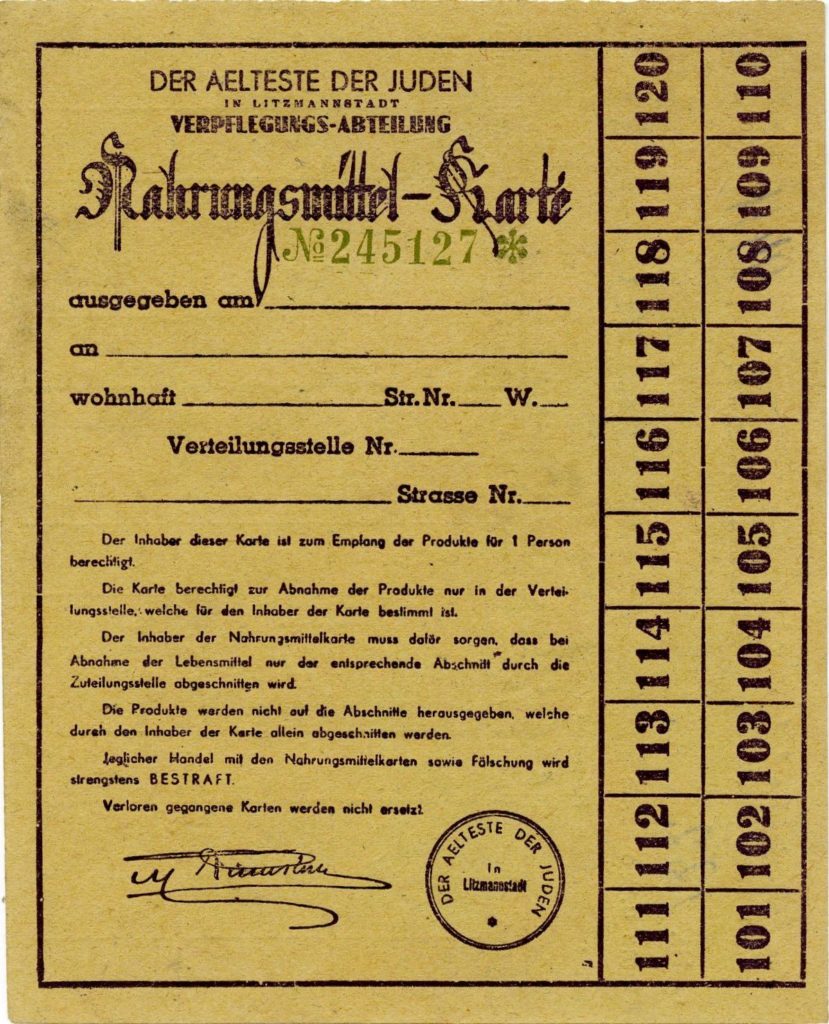
Milch Karte [Milk Card no. 9411] der Aelteste der Juden in Litzmannstadt. [The Jewish ghetto in Lodz.]
The card owner’s personal details appear on the back of the card – his name, age and address, as well as regulations in German with punishments for losing the card or using it in ways other than as designated by Nazi law.
12×15 cm. Very fine condition.
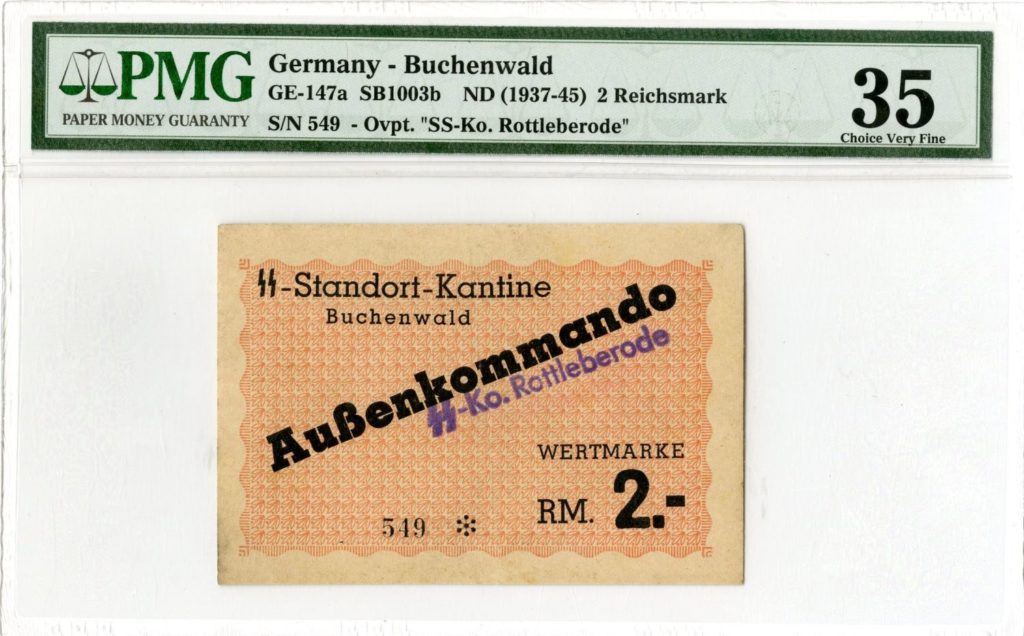
SS Standort-Kantine, Buchenwald – Ausenkommando, SS-KO. Rottleberode. WERTMARKE 2 RM
Banknote with a value of 2 reichsmarks for purchase at the mobile canteen in the Buchenwald death camp, rated 35 Choice Very Fine by the PMG. Low number 549 -Rare.
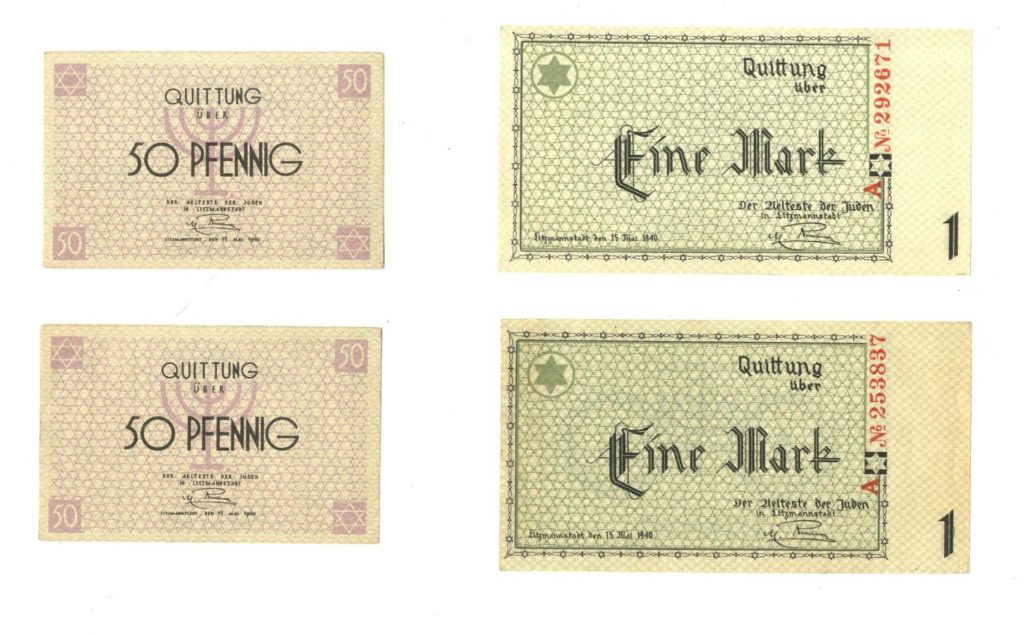
9 banknotes issued in the Lodz ghetto. In many of the ghettos, the Nazis would seize the local money which was in the Jews’ possession and exchange it for substitute money that was of no value outside the ghetto walls.
* 2 20 mark banknotes issued in the Lodz ghetto in May 1940. AU condition.
* 2 10 mark banknotes issued in the Lodz ghetto in May 1940. F condition.
* 2 50 Pfennig banknotes issued in the Lodz ghetto in May 1940. AU condition.
* 2 1 mark banknotes issued in the Lodz ghetto in May 1940. AU condition.
* 50 mark banknote issued in the Lodz ghetto. F condition.
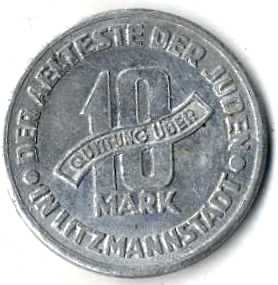
10 mark coin issued by the Judenrat in the Lodz ghetto to serve the ghetto residents. Lodz, 1943.
Cast aluminium. “Der Aelteste der Juden in Litzmannstadt” on one side, and an illustration of a Magen David and “Getto 1943” inscribed in the reverse. Diameter: 3 cm.
Fine condition.
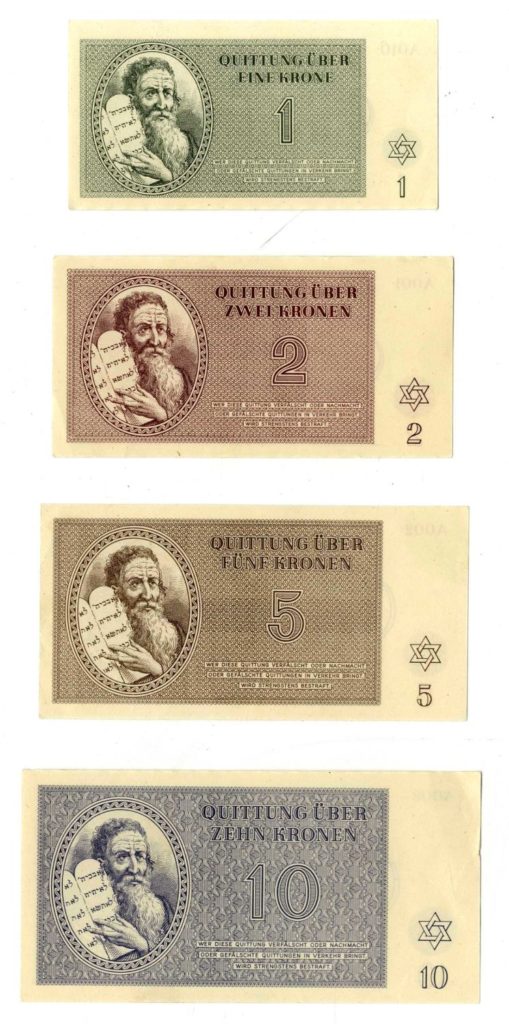
Complete set of the b anknotes issued by the Nazis in the Theresienstadt ghetto for use by the Jews, with values of 100, 50, 20, 10, 5, 2, 1 krone.
UNC condition, no signs of use.
The first camp in which the Nazis issued banknotes for internal use by the Jews was Oranienburg-Sachsenhausen, which was located close to Berlin. Each camp prisoner, and then each ghetto resident, was required to exchange his money and some of his property for banknotes for the camp or ghetto in which he was confined. Owners of the banknotes were not allowed to acquire anything with the local money outside of the ghetto boundaries, as it was valid only within the ghetto. The Nazi’s purpose in this was to prevent an event in which prisoners would succeed in escaping from the camps, so that they would have no means with which to buy food or clothing. This made plans to escape significantly more difficult. It was also the reason the banknotes were of strictly Jewish character. On the Theresienstadt ghetto banknotes, a star of David was printed, and picture of an illustration of Moshe Rabbeinu holding the Ten Commandments. The reason the banknotes were valued in krone [the Czech currency] and not in German marks was due to Theresienstadt’s geographic location in Czechoslovakia (which was mostly occupied by the Nazis before WWII), with the value of the Czech currency. In general, the banknotes of higher values were not used, as buying expensive items was inconceivable in the ghetto. The Nazis just issued banknotes of high values to give the “Jewish economy” the appearance of a regular, flourishing economy, by giving the impression of the “normalcy” of regular, orderly daily life, which the Nazis took pains to present to the representatives of the Red Cross who visited the ghetto.
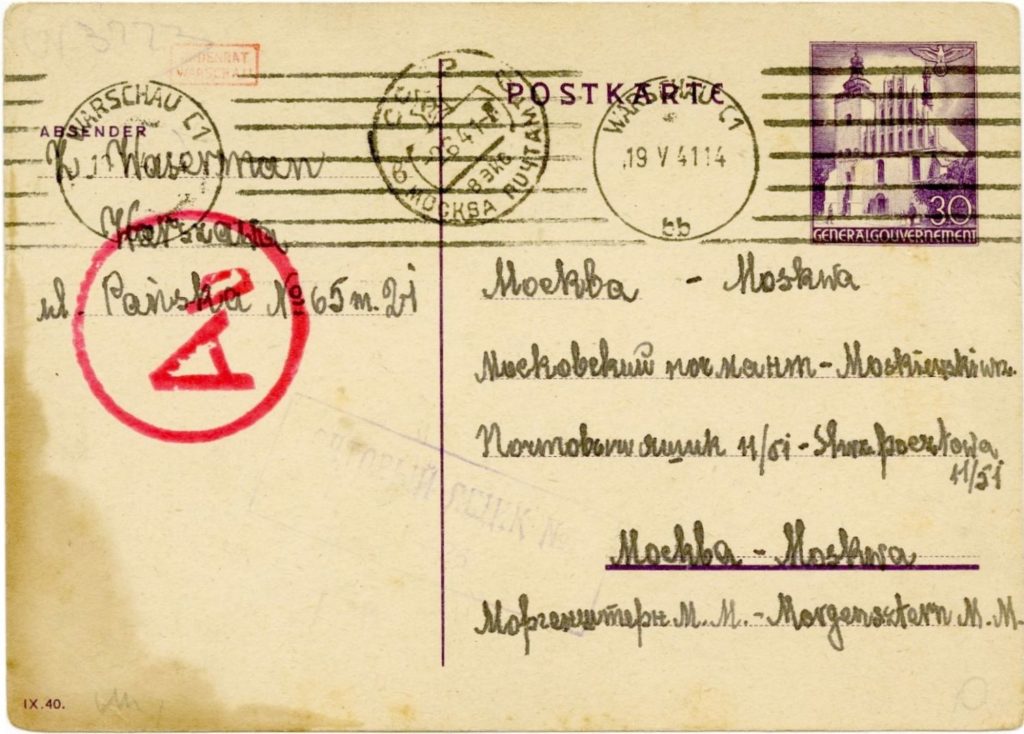
Postcard sent from the Warsaw ghetto on 19/5/1941 with the Warsaw Judenrat stamp in red ink.
The role of the Judenrat was to mediate between the Nazi authorities and the Jewish community. Aside from the ongoing activities that were required to be carried out by the Judenrat – mail, food, welfare, health and more – they were even required to follow mail sent from the ghetto. The purpose of the Nazi authorities was to track the content of the letters that were sent with the intent to use them to reach the relatives of the Jews who were outside of the ghetto, and to find Jews who were subverting Nazi rule. A postcard which was stamped by the Judenrat indicated that it met the strict criteria set by the Nazis for outgoing mail from the ghetto.
Members of the Judenrat were used as liason between the Jews and the Nazis. They were forced to meet the demands of both sides, which almost always contradicted each other. The Germans demanded that their instructions be carried out, and the Jews hoped for protection by the Judenrat. Many times, the Judenrat served as a source of anger and bitterness for the Jewish community, who saw the local Judenrat as the source of all its troubles.
11×15 cm. Stains. Fine condition.
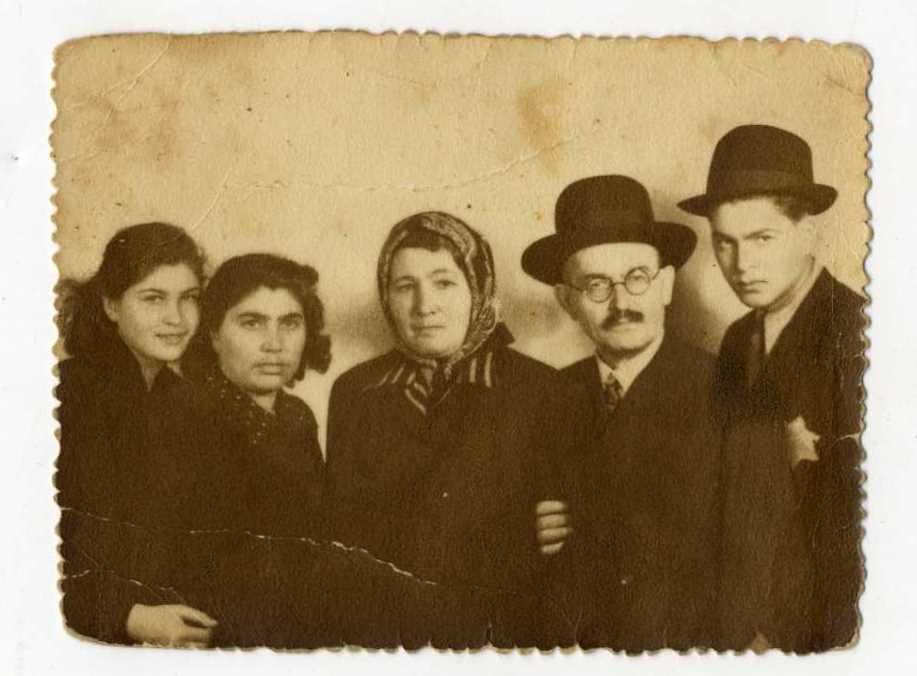
Photograph of a Jewish family in a ghetto. A yellow patch can be discerned on the clothing of the person standing on the right.
Various hypotheses were raised as to the identity of those photographed, but their identity was not clarified for us.
6.5×8.5 cm. Slight cracks. Fine condition. Period handwritten inscription on the reverse of the photograph. (Not examined.)
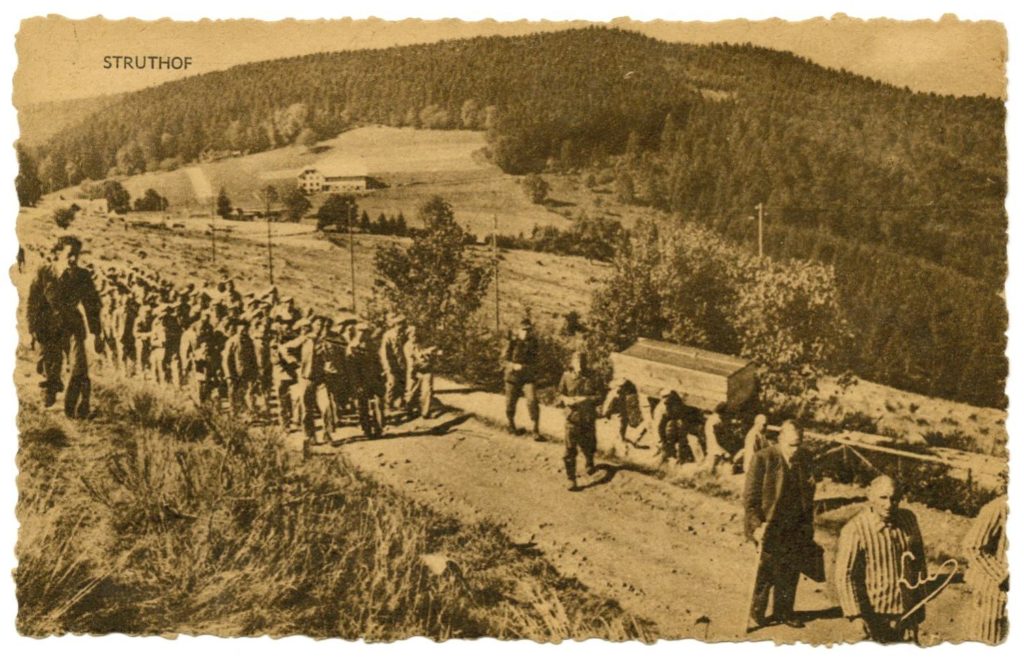
Five postcards depicting various views from the Struthof death camp. Each postcard is described on its reverse. Published by C. O. S. O. R.
The postcards show a general view of the camp, muselmann prisoners in a march, the crematorium [which was built in the camp upon its opening and active throughout the existence of the camp], the camp barracks, the gas containers.
The Nazweiler Struthof camp established by the Nazis in northern France functioned as a concentration and labor camp 1941-1944. It was liberated by the Allied forces in 1944 while it contained approximately 20,000 prisoners. There were also human experiments performed there. Over the course of its existence, the Nazis murdered about 40,000 people there.
Very fine condition.
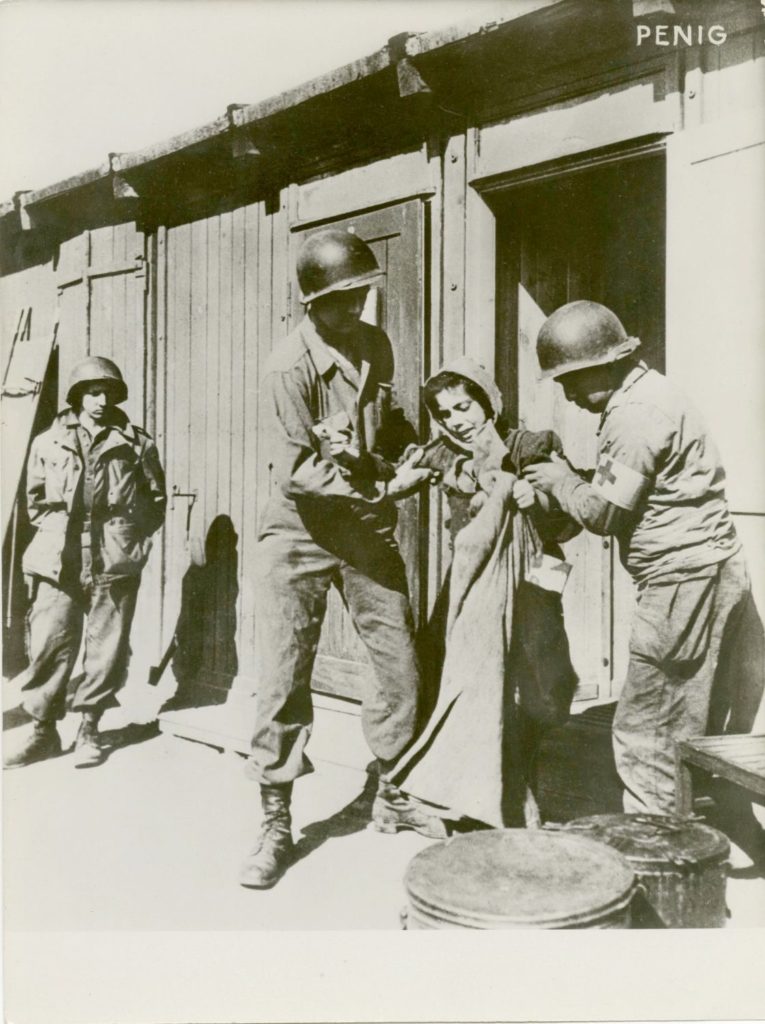
15 large photographs taken by the Allied forces on the day the camps were liberated 1944-1945. The photographs were distributed after the Holocaust in educational frameworks in Germany as part of the “re-education” of the German population in the spirit of the values of democracy and peace. All are stamped on the reverse with the ink stamp of the American Photography Agency.
Photographs of the Nordhausen, Vaihigen, Belsen, Dachau, Ohrdurf and Buschenwald and other camps. In the photographs: Allied forces looking at the hanging ropes, American soldiers assisting Jewish survivors, German civilians forced to help bury corpses, extremely thin prisoners rescued on the verge of death, harsh photographs of scorched corpses, and more. Some of the photographs are difficult to view.
The Western democracies, especially the United States and Britain, were eager to present the crimes of the Nazi regime to their own public in order to justify the many victims and the mass recruitment. As a result of this, their governments made considerable efforts to document, as much as possible, the process of the camps’ liberation and what was found in them. To this end, resources were allocated, including much photographic and film equipment [many photographs from liberation day appeared in the film Death Stations produced for the United States Office of War Information for the re-education of the German population, as well as in Night Will Fall directed by André Singer]. Civilian photographers and film crews were brought in an organized way to the camps. Aside from media needs, the product of their work was included by the prosecution for the trials planned for the war criminals. Later on, they were also used for re-education of the conquered German population in the spirit of democratic values. Either way, these photographs, although difficult to view, are visual documentation of the first order to the atrocities perpetrated by the Germans under the auspices of the Führer and the Reich in the Nazi death camps.
The photographs are identically sized: 17×23 cm. Very fine condition.